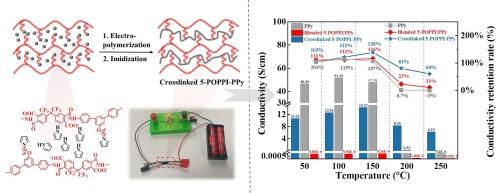高导电性耐热交联聚酰亚胺-聚吡咯的制备及性能研究
IF 5.1
3区 工程技术
Q1 CHEMISTRY, APPLIED
引用次数: 0
摘要
随着人们对高温导电应用的兴趣日益浓厚,对导电聚酰亚胺(pi)的需求激增。然而,现有的导电pi在实现高导电性和良好热性能之间的平衡方面仍然存在挑战。为了获得同时具有优异导电性和热性能的PI,本研究制备了含有吡咯部分的二胺(5-POPDA),随后与4,4 ' -(六氟异丙基)二苯二酸酐(6FDA)缩聚得到聚酰胺(5-POPPAA)。电离后,5-POPPAA与掺杂剂和吡咯单体结合,形成悬浮液,随后通过电泳沉积程序。在此过程中,沉积5-POPPAA薄膜,悬浮吡咯单体与5-POPPAA的悬垂吡咯基团之间同时发生电化学聚合,形成聚吡咯(PPy)。这就得到了交联的5-POPPAA-PPy,化学亚胺化得到交联的5-POPPAA-PPy。扩展π共轭PPy结构的形成使得5-POPPI-PPy的电导率达到了10.53 S/cm。此外,由于5- poppi和PPy分子链之间的共价交联,5- poppi -PPy在453°C和479°C的失重温度分别为5%和10% (Td5%和Td10%)时表现出优异的热稳定性。此外,交联的5-POPPI-PPy薄膜具有良好的力学性能和良好的高温导电性。纯PPy经250℃退火后电导率下降,5-POPPI-PPy的电导率为6.23 S/cm。该研究为开发适合高温导电应用的导电pi提供了有见地的理论信息。本文章由计算机程序翻译,如有差异,请以英文原文为准。

Preparation and properties of highly electrically conductive and heat-resistant crosslinked polyimide-polypyrrole
With the growing interest in high-temperature conductive applications, the demand for electrical conductive polyimides (PIs) has surged. However, the existing conductive PIs still remain challenges in achieving a balance between high conductivity and good thermal performance. To obtain PI simultaneously exhibiting superior conductivity and thermal properties, in this study, a diamine (5-POPDA) bearing pyrrole moiety was prepared and subsequently polycondensed with 4,4′-(hexafluoroisopropylidene) diphthalic anhydride (6FDA) to yield poly(amic acid) (5-POPPAA). After being ionized, the 5-POPPAA was combined with dopants and pyrrole monomers to create a suspension, which was subsequently put through an electrophoretic deposition procedure. In the procedure, the 5-POPPAA film was deposited, and simultaneous electrochemical polymerization occurred between suspended pyrrole monomers and pendant pyrrole groups of 5-POPPAA to form polypyrrole (PPy). This resulted in the crosslinked 5-POPPAA-PPy, which was chemical imidized to yield crosslinked 5-POPPI-PPy. The creation of extended π-conjugated PPy structure resulted in a large conductivity of 10.53 S/cm for 5-POPPI-PPy. Additionally, 5-POPPI-PPy demonstrated excellent thermal stability with 5 % and 10 % weight-loss temperatures (Td5% and Td10%) of 453 °C and 479 °C, respectively, benefiting from the covalent crosslinking between the 5-POPPI and PPy molecular chains. Moreover, the crosslinked 5-POPPI-PPy film exhibited good mechanical characteristics and remarkable high-temperature conductivity retention. While pure PPy lost its conductivity by being annealed at 250 °C, 5-POPPI-PPy retained a conductivity of 6.23 S/cm. This study offers insightful theoretical information for the development of conductive PIs tailored for conductive applications in high temperature.
求助全文
通过发布文献求助,成功后即可免费获取论文全文。
去求助
来源期刊

Reactive & Functional Polymers
工程技术-高分子科学
CiteScore
8.90
自引率
5.90%
发文量
259
审稿时长
27 days
期刊介绍:
Reactive & Functional Polymers provides a forum to disseminate original ideas, concepts and developments in the science and technology of polymers with functional groups, which impart specific chemical reactivity or physical, chemical, structural, biological, and pharmacological functionality. The scope covers organic polymers, acting for instance as reagents, catalysts, templates, ion-exchangers, selective sorbents, chelating or antimicrobial agents, drug carriers, sensors, membranes, and hydrogels. This also includes reactive cross-linkable prepolymers and high-performance thermosetting polymers, natural or degradable polymers, conducting polymers, and porous polymers.
Original research articles must contain thorough molecular and material characterization data on synthesis of the above polymers in combination with their applications. Applications include but are not limited to catalysis, water or effluent treatment, separations and recovery, electronics and information storage, energy conversion, encapsulation, or adhesion.
 求助内容:
求助内容: 应助结果提醒方式:
应助结果提醒方式:


